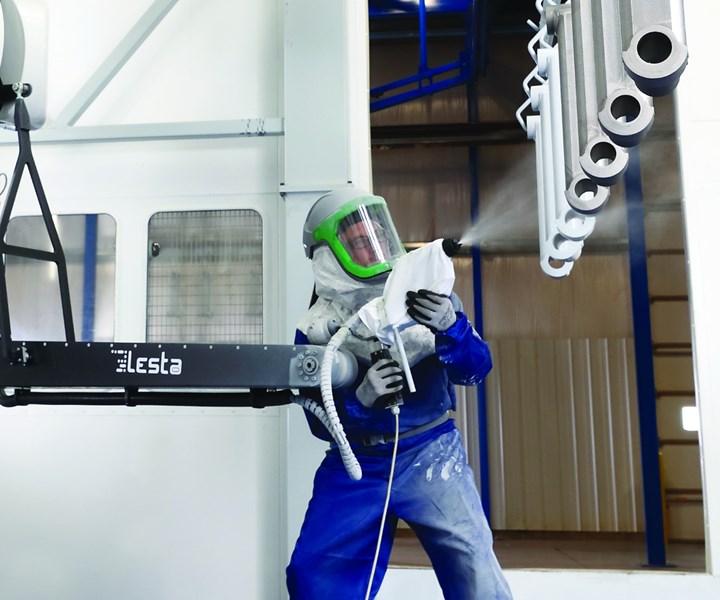LestaUSA Brings Self-Learning Italian-Engineered Robotic Finishing Technology to U.S.
With roots in Italy, supplier offers affordable technology for liquid, powder coat and fiberglass applications.

Lesta robots go into a weightless learning mode while in the hands of a company’s best finisher, who then completes the finishing cycle on a desired part as the software creates its own robotic code of every movement and spray technique.
Lesta has entered the U.S. finishing market as LestaUSA to allow manufacturers of any size to incorporate robotic finishing technology without the need for complicated programming or teach pendants.
LestaUSA is the North American distributor, integrator, manufacturer and technical support for mechanical and software of Lesta robots built for industrial finishing applications. With its roots in Italy, the South Dakota-based LestaUSA says it offers affordable technology for liquid, powder coat and fiberglass applications.

The finisher’s exact technique, including the application of the paint or powder, is saved and then mirrored by the robot on future jobs.
Lesta says its robotic technology can be used for liquid, powder coating and fiberglass on metal, wood, composite materials, ceramics and plastics. The company has over 300 systems being used worldwide in small, mid and large companies.
“Our robotic technology itself isn’t new,” said Derek DeGeest, president of LestaUSA. “What’s unique here is that Lesta’s proven technology is so simple that, upon completion of the installation, a manufacturer of any size can literally be making their own programs and finishing robotically on day one.”
LestaUSA says its system is self learning and only needs a painter or finishing specialist. Lesta robots go into a weightless learning mode while in the hands of a company’s best finisher, who then completes the finishing cycle on a desired part as the software creates its own robotic code of every movement and spray technique. The finisher’s exact technique, including the application of the paint or powder, is saved and then mirrored by the robot on future jobs.
“Painters are amazed when they see their work automated by the robot,” DeGeest says. “It’s like capturing the knowledge of your best painter and hitting copy and repeat to free up your talent to help your company accomplish more.”
LestaUSA also offers a solution for eliminating moisture on parts during the finishing preparation process by developing suction and blow-off robots.
Brad Ruppert, finishing applications specialist for LestaUSA, says manufacturers with a multistage wash process in their coating operation struggle removing pockets of standing water, even with the aid of a dry-off oven. Traditional methods of eliminating moisture include manually blowing off every part destined for the oven, reengineering parts to contain more drain holes or raising oven temperature to evaporate standing water.
“Our suction and blow-off robots are simple to program for eliminating water pockets prior to entering the dry-off oven, thus saving time and money,” Ruppert says.
The Lesta suction and blow-off robot does not require complicated programming or teach pendants. While in a weightless learning mode, a finishing line attendant guides the robot through the appropriate sequence to ensure the moisture is dealt with as the software creates its own robotic code of every movement.
Visit lestausa.com.
Related Content
-
Masking Solutions Provider CFS Dramatically Expands Capabilities and Capacity
Custom Fabrication & Supplies (CFS) completed a new plant expansion packing 10 times the capacity into twice the space. It dramatically enhances the supplier’s custom capabilities to provide extremely precise and cost-effective masking solutions.
-
Conveyors and Paint Systems
Choosing the right conveyor system, coating technology, and ancillary equipment.
-
Cobot Enters Paint Industry With Safety at the Forefront
This collaborative robot is the first explosion-proof solution for the powder coating and paint arena that meets the U.S.’ stringent safety requirements. Its lead-through teach programming and tablet control are especially appealing to small shops with little proficiency in robotics.













.jpg;maxWidth=300;quality=90)


